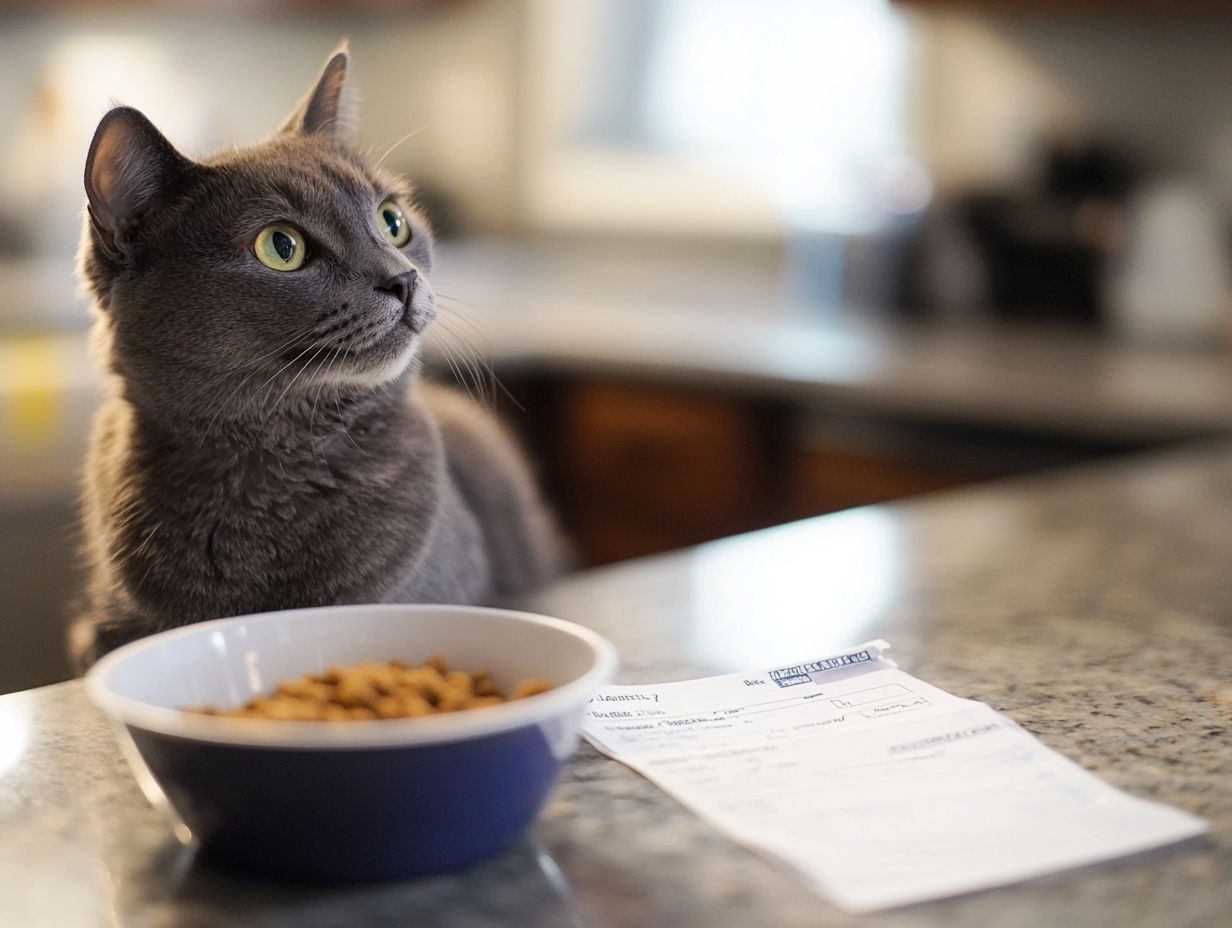Preparing your cat for an ultrasound is essential for achieving accurate results and ensuring a smooth experience. Proper preparation can significantly impact the quality of the ultrasound images and the overall outcome of the procedure.
Understanding what to expect—from feeding guidelines to medication restrictions—is crucial for a seamless ultrasound experience. Always verify fasting guidelines and medication restrictions with your veterinarian or trusted veterinary sources to ensure factual accuracy tailored to your cat’s needs.
This guide walks you through everything you need to know before, during, and after the ultrasound procedure.
By following these tips, you’ll ensure your furry friend is comfortable and ready for their ultrasound exam, giving you peace of mind every step of the way.
Key Takeaways:

- It is important to prepare for a cat sonogram by understanding what to expect and how to properly prepare your cat for the exam, including pre-medication and sedation preparation if necessary.
- Guidelines recommend withholding food for at least 8-12 hours before a cat sonogram to ensure accurate results and minimize potential complications during the ultrasound procedure.
- In addition to restricting food, it is also important to follow guidelines for medications and activities before a cat sonogram to ensure the best possible outcome and accurate ultrasound findings.
Preparing for a Cat Sonogram
Proper preparation for a cat sonogram is essential to ensure that pets receive optimal care during the ultrasound exam. A clear understanding of the preparation instructions can help minimize potential stress for both the pet and the owner, enhancing the emotional well-being of your pet.
Pet owners should familiarize themselves with the ultrasound procedure and the roles of veterinary professionals, such as registered diagnostic medical sonographers, who will conduct the exam using advanced imaging methods.
An effective preparation process enhances the benefits of the ultrasound by ensuring accurate results, which can lead to appropriate diagnosis and treatment of heart conditions or organ abnormalities.
What to Expect and How to Prepare
This involves fasting your furry friend for several hours before the appointment (typically 8-12 hours) to achieve clearer imaging results. Reducing playtime and minimizing stress can also contribute to a smoother experience, as a calm cat is easier to examine and enhances overall patient care.
Bringing along any previous medical records or notes will assist the veterinarian in providing a more comprehensive assessment. Understanding the general process not only alleviates anxiety for both the pet and the owner but also significantly enhances diagnostic accuracy and the overall effectiveness of the procedure, ensuring that the pet receives optimal care and benefits from the ultrasound diagnosis.
Feeding Guidelines
Can a Cat Eat Before a Sonogram?
Regarding scheduling an ultrasound exam for your cat, one crucial question arises: Can a cat eat before a sonogram? The answer is generally no, as fasting recommendations are typically advised to ensure accurate ultrasound results. Checking the cancellation policy of your veterinary clinic can also help in case of appointment changes.
Pets fasting prior to an abdominal ultrasound helps enhance the clarity of the ultrasound images, which can lead to better diagnosis and treatment provided by veterinary care professionals and board-certified radiologists.
Guidelines for Feeding Before the Exam

Following cat sonogram feeding guidelines is crucial to ensure that your pet is adequately prepared for the examination. Typically, this preparation involves withholding food for 8-12 hours prior to the exam, allowing the digestive tract to clear, which is essential for obtaining high-quality images during the ultrasound, especially for abdominal organs.
Owners should avoid giving their cats high-fat foods or treats, as these can affect the results. Adhering to these guidelines enhances the visualization of the organs and reduces the risk of complications during the ultrasound procedure, making the process safer.
Proper preparation can ultimately lead to more accurate diagnoses and better patient outcomes, making the entire process easier for both the animal and the owner.
Other Pre-Exam Considerations
It is important to observe your cat for any signs indicating urgent care is needed post-ultrasound, such as excessive vomiting, lethargy, or difficulty breathing.
Make sure to bring any necessary items to your appointment, such as medications your cat is currently taking and a list of symptoms you’re concerned about. This will assist your veterinarian in providing thorough care.
Signs to Monitor After the Exam:
- Behavioral Changes: Monitor your cat’s behavior for any changes in appetite or energy levels after the procedure. Such changes may indicate complications from anesthesia or sensitivity to medications.
- Follow-Up Appointments: The ultrasound findings may necessitate follow-up visits to monitor your cat’s condition. These appointments could include brief physical examinations or more extensive tests, such as blood work or repeat imaging, required days, weeks, or even months after the initial visit. Regular veterinary imaging can help track your cat’s health progress.
- Medications: If medications were prescribed for recovery, ensure that the correct dosage is administered for the prescribed duration. If your cat is on a special diet, consult your veterinarian for tailored pre-sonogram recommendations.
In conclusion, following these preparation guidelines is vital for a successful ultrasound experience. By ensuring your cat is well-prepared, you can facilitate accurate results and contribute to better health outcomes for your furry friend.
Preparing your cat for a sonogram is crucial for accurate results. This guide outlines the necessary steps, including medication restrictions, food intake, and what to expect during and after the procedure.
Along with fasting, there are other important factors that pet owners should be aware of when preparing for a cat sonogram. These include any restrictions on medications or activities that could interfere with the ultrasound process, such as high-intensity exercises.
Some exams may require sedation, so it is essential for pet owners to understand whether anesthesia will be needed, as this can impact the patient’s care and comfort during the ultrasound examination. Discussing sedation preparation with your veterinary clinic is crucial.
Restrictions on Medications and Activities
Understanding the restrictions on medication and activities before a cat sonogram is crucial, as these factors can impact the effectiveness of the ultrasound procedure. Some medications that affect the heart or blood pressure may need to be avoided to ensure accurate imaging results and optimal patient care.
Pet owners should also limit their cat’s food intake in the hours leading up to the exam, as a full stomach can block ultrasound waves and obscure the images. Additionally, keeping the cat calm and avoiding stressful activities before the appointment is essential for obtaining reliable results; a relaxed animal is less likely to move, resulting in a clearer scan and better diagnostic imaging.
- Limit food intake 8-12 hours before the exam.
- Avoid high-intensity activities for at least 24 hours before the appointment.
What Happens During a Cat Sonogram
A cat ultrasound is a non-invasive procedure that utilizes an ultrasound machine to obtain diagnostic images of your pet’s internal organs. High-frequency sound waves generate these ultrasound images, which board-certified radiologists assess for any abnormalities or signs of heart disease, liver issues, or other organ abnormalities.
Understanding the ultrasound procedure can help alleviate the concerns of pet owners and better prepare them for their pet’s examination, ensuring a smoother process.
The Procedure and What to Expect

The cat sonogram procedure is a diagnostic imaging technique that utilizes an ultrasound machine while prioritizing patient comfort. This machine employs high-frequency sound waves, which are safely transmitted through the body to create real-time images of internal structures such as the liver, kidneys, and spleen.
As the examination begins, the veterinarian or technician will carefully place the cat on an exam table and apply a warm, conductive gel to enhance the quality of the images. To ensure the pet remains still during the procedure, the staff will speak softly and gently stroke the cat to encourage relaxation, maintaining a focus on patient comfort.
They will continuously monitor the pet’s comfort level and make necessary adjustments to keep stress levels low, ensuring that the procedure is as calm and reassuring as possible for both the pet and the owner, highlighting the importance of emotional well-being.
After the Sonogram
After a cat sonogram, it is crucial for pet owners to understand the post-exam care and what to expect regarding the ultrasound results. Veterinary professionals will provide an ultrasound report that details the findings and outlines any necessary next steps for treatment or further diagnostic procedures. Understanding the implications of the ultrasound findings is essential for ongoing care.
Ensuring the comfort of both the pet and the owner during this phase is essential, as pet owners may have questions about the implications of the ultrasound findings and their pet’s overall health.
Risks of Non-Compliance
Failing to follow pre-exam protocols can lead to inaccurate imaging or the need for additional procedures. It’s important to adhere to the guidelines to avoid complications that could affect your cat’s health.
Post-Exam Care and Next Steps
Post-exam care is essential for your cat’s health and comfort following a sonogram, and understanding what to expect is crucial. The veterinarian will interpret the ultrasound results, and any noted changes may affect your cat’s future health. These changes could lead the veterinarian to recommend additional follow-up appointments or diagnostic tests, ensuring comprehensive patient care.
By adhering to these guidelines, you can ensure a smooth experience for your cat during the sonogram, leading to accurate results and better health outcomes.
Frequently Asked Questions
Can a cat eat before a sonogram?

No, it is recommended that a cat does not eat before a sonogram. The food in their stomach can interfere with the imaging results, making it difficult for the veterinarian to identify potential issues, thereby affecting the overall effectiveness of the procedure.
How long should I withhold food from my cat before a sonogram?
It is best to withhold food from your cat for at least 8-12 hours before their sonogram. This ensures their stomach is empty, leading to more accurate imaging results and diagnoses.
Should I Withhold Water Before My Cat’s Sonogram?
Your cat may drink water before the sonogram, but limit their intake to avoid a full bladder during the procedure, ensuring clearer imaging results.
What if my cat has a medical condition and needs to eat before the sonogram?
If your cat has a medical condition requiring them to eat before the sonogram, inform the veterinarian beforehand. They may recommend a specific diet to follow before the procedure, ensuring pre-exam guidelines are met without compromising your cat’s health.
Are there any other pre-exam guidelines for a cat before a sonogram?
Yes, it’s important to also withhold any medications or supplements before the sonogram, unless otherwise directed by the veterinarian. Certain medications can interfere with imaging results, so following these guidelines is crucial for optimal ultrasound diagnosis.
Can I still give my cat their regular meals after the sonogram?
Yes, after the abdominal ultrasound is completed, you can resume your cat’s regular feeding schedule. Follow any post-exam instructions given by the veterinary clinic, including any recommended medications or dietary changes. Make sure to adhere to any fasting recommendations provided before the ultrasound exam.
Summary: Following these pre-exam guidelines is crucial for accurate imaging and effective diagnostics. By adhering to these steps, you can help ensure your cat’s sonogram is successful and stress-free.